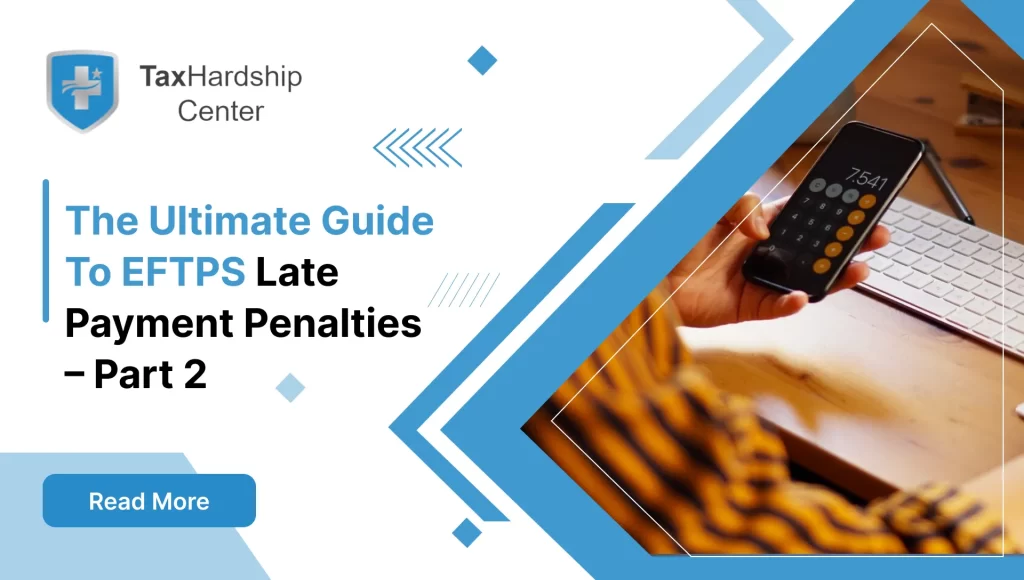Navigating the complexities of IRS penalties and tax regulations can be daunting for many taxpayers. The prospect of dealing with penalties for late filing, late payment, or inaccuracies can add significant stress to an already challenging situation. At Tax Hardship Center, we understand these challenges and are dedicated to providing expert assistance to ensure a smooth and effective tax resolution process. This blog will explore how our services can help you request penalty abatement, manage your tax situation, and provide ongoing support to maintain compliance with IRS regulations.
Understanding Penalty Abatement
Penalty abatement, a critical mechanism in tax compliance, allows taxpayers to alleviate penalties imposed by the Internal Revenue Service (IRS). Penalties, often a consequence of non-compliance, can accrue for various reasons, including late filing, late payment, or inaccuracies in tax returns. Understanding and effectively navigating penalty abatement strategies is paramount, as it alleviates financial burdens and ensures taxpayers remain compliant with IRS regulations. This article delves into the intricacies of penalty abatement, exploring the types of penalties, their reasons, and the avenues available for seeking relief.
How Tax Hardship Center Eases Tax Concerns
Navigating the complexities of IRS penalties and tax regulations can be overwhelming. At Tax Hardship Center, we understand individuals’ challenges and are here to help ensure a smooth tax resolution process.
Our experts can assist with:
- Requesting Penalty Abatement: We’ll guide you through the process of requesting penalty relief, whether it’s for reasonable cause, first-time penalty abatement, or other options.
- Accurate Data Entry: To prevent issues with your tax resolution, we’ll ensure all forms and documentation are completed accurately and thoroughly.
- Ongoing Support: We provide continuous support to help you manage your tax situation, stay compliant with IRS regulations, and address any changes in your financial circumstances.
- Tax Planning Advice: Receive personalized advice on tax planning to optimize your financial situation and manage your tax liabilities effectively.
Focus on resolving your tax issues; we’ll handle the complexities of IRS penalties and abatement requests! Schedule a free consultation with the Tax Hardship Center today.
Types of Penalties
The IRS imposes several penalties on taxpayers, each designed to enforce compliance and encourage timely and accurate tax filing. Some of the most common penalties include:
- Failure-to-File Penalty: This penalty is incurred when taxpayers fail to file their tax return by the due date. The penalty is typically 5% of the unpaid taxes for each month the return is late, up to a maximum of 25%. This substantial penalty underscores the importance of timely filing, even if the taxpayer cannot pay the owed amount immediately.
Imagine Person A owes $1,000 in taxes and forgets to file their return by the due date. They filed it three months later.
- Penalty: 5% per month (up to 25% max).
- Calculation: 3 months * 5% = 15% of the unpaid tax ($1,000).
- Amount Owed: 15% * $1,000 = $150 penalty.
- Failure-to-Pay Penalty: This penalty arises when taxpayers do not pay the taxes owed by the due date. The penalty is generally 0.5% of the unpaid taxes for each month the payment is late and capped at 25%. While it may seem less severe than the failure-to-file penalty, it can quickly add up, especially for significant tax liabilities.
Person B owes $2,000 in taxes and pays only half by the due date. They wait four months to pay the remaining balance.
- Penalty: 0.5% per month (up to 25% max).
- Calculation: 4 months * 0.5% = 2% of the unpaid tax ($1,000).
- Amount Owed: 2% * $1,000 = $20 penalty (added to remaining tax).
- Accuracy-Related Penalties: These penalties are imposed for substantial understatement of income tax, negligence, or disregard of rules and regulations. The penalty is usually 20% of the understated tax amount. This penalty ensures taxpayers provide accurate and complete information, thereby maintaining the tax system’s integrity.
Person C needs to report $5,000 of income on their tax return. This is considered a substantial understatement.
- Penalty: 20% of the understated tax amount.
- Calculation: 20% * $5,000 = $1,000 penalty.
Penalties are calculated based on the amount owed and the duration of non-compliance, creating a compounding effect that can significantly increase the taxpayer’s liability. Understanding these penalties is the first step toward effective tax management and compliance.
Reasons for Penalties
Taxpayers may incur penalties for various reasons, including but not limited to missing filing deadlines, underreporting income, and negligence. Understanding these scenarios is essential in avoiding penalties:
- Missing Deadlines: Failing to file tax returns or pay due taxes within the stipulated time frame can result in immediate penalties. Timely filing and payment are crucial components of tax compliance.
- Underreporting Income: Inaccurately reporting income, either through omission or error, can lead to substantial penalties, especially if the understatement is significant. Accurate reporting is essential to avoid these penalties.
- Negligence or Disregard of Rules: Failing to comply with tax laws and regulations intentionally or due to carelessness can attract accuracy-related penalties. Ensuring a thorough understanding and adherence to tax laws is vital for compliance.
A comprehensive understanding of tax obligations is paramount, as ignorance of the law is not considered a valid excuse for non-compliance. Proactively managing tax responsibilities can help mitigate the risk of incurring penalties.
Penalty Abatement Criteria
Penalty abatement provides a pathway for taxpayers to seek relief from penalties under specific conditions. The IRS offers several criteria under which penalties can be abated:
- Reasonable Cause: Penalties may be abated if the taxpayer can demonstrate that they exercised ordinary business care and prudence but could not comply with the tax obligations due to circumstances beyond their control. This could include unforeseen events such as natural disasters or severe illness.
- First-Time Penalty Abatement (FTA): This program allows eligible taxpayers to request abatement of specific penalties once in their lifetime, provided they have a clean compliance history. This is particularly beneficial for taxpayers who typically maintain good compliance but face an isolated incident of non-compliance.
- Administrative Waivers: Penalties may also be abated in cases where there was an administrative error or delay on the part of the IRS. Taxpayers should keep thorough records to support claims of administrative errors.
Situations that may qualify for penalty relief include serious illness, natural disasters, or reliance on incorrect professional advice. Understanding these criteria can significantly aid taxpayers in successfully requesting penalty abatement.
Steps to Request Abatement
Requesting penalty abatement involves a structured process, requiring the submission of specific forms and supporting documentation. The steps include:
- Submitting Form 843: Taxpayers must complete and submit Form 843, Claim for Refund and Request for Abatement, detailing the reasons for the abatement request. Accurate and detailed completion of this form is crucial for the success of the request.
- Providing Supporting Documentation: The form must include documentation supporting the claim, such as medical records, correspondence with the IRS, or evidence of natural disasters. This evidence is critical to substantiating the claim for abatement.
- Explanation Letter: A detailed explanation letter describing the circumstances that led to the penalty may enhance the chances of acceptance. This letter should clearly articulate the reasons for non-compliance and how they align with the abatement criteria.
Taxpayers must meticulously follow the process and provide comprehensive and accurate information to support their requests. Proper documentation and clear communication with the IRS can significantly improve the likelihood of a successful abatement request.
Reasonable Cause
Reasonable cause for penalty relief is determined on a case-by-case basis, considering all the facts and circumstances surrounding the non-compliance. Some factors that may constitute reasonable cause include:
- Serious Illness or Death: If the taxpayer or a close family member was seriously ill or deceased when the tax return was due, this may be considered reasonable cause. Providing medical records and other relevant documentation can support this claim.
- Natural Disasters: Events such as hurricanes, floods, or wildfires that prevent the taxpayer from complying can be grounds for penalty abatement. Evidence of the disaster’s impact on taxpayers’ ability to file or pay taxes is necessary.
- Reliance on Professional Advice: If a taxpayer relies on incorrect or misleading advice from a tax professional, it may qualify as a reasonable cause. Documentation of the advice and the professional’s credentials can support this claim.
Demonstrating reasonable cause requires a clear, concise articulation of the circumstances and how they directly impacted the taxpayer’s ability to comply. Thorough documentation and a well-crafted explanation are key to a successful, reasonable cause claim.
First-Time Penalty Abatement (FTA)
The First-Time Penalty Abatement (FTA) program is a beneficial provision for taxpayers who have a clean compliance history. The key features of the FTA program include:
- Eligibility Criteria: To qualify for FTA, the taxpayer must have:
- Filed all required tax returns or filed an extension.
- Paid or arranged to pay any tax due.
- No significant penalties or interest were charged in the prior three years.
- Application Process: Taxpayers can request an FTA by calling the IRS or submitting a written request. The IRS will review the taxpayer’s compliance history and determine eligibility. Clear and concise communication with the IRS can expedite the process.
- Lifetime Limit: The FTA can only be used once in a taxpayer’s lifetime, making it a valuable resource that should be utilized judiciously. Understanding the lifetime limit ensures taxpayers decide when to request FTA.
Taxpayers should meet the eligibility criteria before seeking relief under the FTA program to avoid unnecessary rejections. Proper preparation and understanding of the criteria can enhance the chances of successful reduction.
Other Abatement Options
In addition to Reasonable Cause and FTA, other abatement options are available for taxpayers:
- Safe Harbor Rule: This rule applies to accuracy-related penalties, providing a safe harbor if the taxpayer can demonstrate that they comply with the law based on the information available at the time. Understanding and utilizing the safe harbor provisions can help avoid penalties.
- Installment Agreements: Entering into an installment agreement with the IRS to pay off the tax debt may sometimes result in penalty abatement. Negotiating an installment agreement can provide financial relief and reduce penalties.
- Offer in Compromise (OIC): In some instances, taxpayers can negotiate an OIC, allowing them to settle their tax debt for less than the total amount owed, which may include penalty relief. Consulting a tax professional can provide valuable insights and personalized advice on the best abatement options.
Exploring these additional options can provide taxpayers with alternative pathways to relief, especially in complex or unique situations.
Conclusion
Penalty abatement strategies are essential tools for taxpayers seeking relief from the financial burden of IRS penalties. By understanding the types of penalties, the reasons behind their imposition, and the criteria for abatement, taxpayers can navigate the complexities of tax compliance more effectively. Reasonable cause, First-Time Penalty Abatement, and other options provide viable relief pathways contingent on each case’s circumstances.
Ultimately, staying informed and proactive in addressing tax obligations is paramount in avoiding penalties and ensuring compliance with IRS regulations. By leveraging these strategies, taxpayers can mitigate financial strain and maintain a favorable compliance history. Understanding penalty abatement is about alleviating penalties and fostering a proactive approach to tax compliance. Taxpayers are encouraged to stay informed about their obligations, seek professional advice when necessary, and promptly address discrepancies. By doing so, they can effectively manage their tax liabilities and avoid the cascading effects of non-compliance penalties.
Why Tax Hardship Center?
1. Hassle-Free Assistance:
Say goodbye to sleepless nights and endless tax-related stress. At the Tax Hardship Center, we believe in simplifying the complex. Our team of experts is dedicated to guiding you through every step of the process, ensuring that your tax concerns are met with precision and care.
2. 14-Day Money Back Guarantee:
We’re so confident in our ability to ease your tax worries that we offer a 14-day money-back guarantee. If, for any reason, you’re not satisfied with our service, we’ll gladly refund your investment. Your peace of mind is our top priority!
3. Free Consultation:
Are you curious about how we can transform your tax experience? Book a free consultation now! Our team will assess your situation, answer your questions, and provide free insights tailored to your needs.
4. Nationwide Coverage:
No matter which corner of the United States you call home, the Tax Hardship Center covers you. We proudly serve all 50 states, bringing our expertise to your doorstep. Wherever you are, our commitment to excellence follows.
FAQs:
1. What is penalty abatement?
Penalty abatement allows taxpayers to request relief from IRS-imposed penalties due to circumstances such as late filing, late payment, or inaccuracies in tax returns. It helps reduce financial burdens and encourages compliance.
2. What are the common types of IRS penalties?
Common IRS penalties include Failure-to-File Penalty, Failure-to-Pay Penalty, and Accuracy-Related Penalties. These penalties aim to enforce compliance and ensure accurate and timely tax filings.
3. What is the Failure-to-File Penalty?
The Failure-to-File Penalty is imposed when taxpayers fail to file their tax return by the due date. It is typically 5% of the unpaid taxes for each month the return is late, up to a maximum of 25%.
4. What is the Failure-to-Pay Penalty?
The Failure-to-Pay Penalty arises when a taxpayer does not pay the taxes owed by the due date. The penalty is generally 0.5% of the unpaid taxes for each month the payment is late, capped at 25%.
5. What are Accuracy-Related Penalties?
Accuracy-related penalties are imposed for substantial understatement of income tax, negligence, or disregard of rules and regulations. The penalty is usually 20% of the understated tax amount, emphasizing the importance of accurate reporting.








